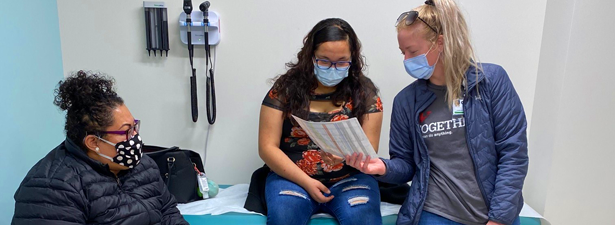Jacksonville Memorial Hospital

Tackling Childhood Asthma in Vulnerable Populations
After seeing 75 pediatric asthma patients in its emergency department (ED) in 2019, Jacksonville Memorial Hospital (formerly Passavant Area Hospital) decided to take action on this potentially life-threatening health condition, the leading chronic disease among American children. Furthermore, asthma diagnoses are five times as common for Black children, who represent roughly one third of the hospital’s pediatric asthma ED patients.
In July 2020, the Morgan County hospital launched the Pediatric Asthma Program in collaboration with American Hospital Association Institute for Diversity and Health Equity and Blue Cross Blue Shield of Illinois. The program provides focused intervention and follow-up support to improve outcomes for some of Jacksonville Memorial’s youngest patients. Although just 12% of Jacksonville’s residents are Black, 36% of program participants are Black.
Hospital leaders decided on a proven approach to helping patients manage chronic conditions: the community health worker (CHW) model. Also used in the hospital’s Healthy Jacksonville program, the CHW model integrates CHWs into the child’s asthma care plan.
CHWs build a trusting relationship by spending time with the child and their family at home, providing tools, education and support, and assessing ways to reduce the triggers of asthma. CHWs ensure the child’s asthma care plan is being followed and evaluate the family’s need for additional services such as establishing a primary care physician or referring the child to specialty care.
Since its inception, the program has yielded incredible results. Each patient enrolled in the program has seen improvement in asthma scores. At the same time, the Jacksonville Emergency Department experienced a 56% decrease in pediatric asthma cases. Managing asthma also helps prevent missed school days.
The program’s success also comes from the work of CHWs to improve individual lives. For example, they discovered many patients lived in homes with water damage—a root cause of an asthma trigger. CHWs worked with landlords and housing managers to provide inspections and maintenance to address this prevalent issue.
After a CHW connected them to specialty care, some patients discovered additional health problems. One 11-year-old patient had extreme activity limitations due to his asthma. A CHW referred him to pulmonologist who identified a curvature in his airway. A simple medical procedure was all it took for the boy to live a normal, active life.

